Acrylic Robotics uses AI and robots to help artists reproduce paintings

Montreal-based Acrylic Robotics is changing the game for visual artists by bringing robotics and artificial intelligence to the world of fine art. The start-up, founded by Chloe Ryan, offers a unique solution for artists to reproduce their paintings on a larger scale without compromising the essence of the original piece.
Ryan, an independent artist and mechanical engineering graduate from McGill University, was inspired to develop this technology after recognizing the limitations painters face in reproducing their art. In contrast, writers and musicians have been able to reproduce their works for broader audiences for centuries.
The Acrylic system allows artists to digitally track their brush strokes, which are then replicated by robots with paintbrush attachments. The potential is vast: instead of selling a single piece for thousands, artists can now offer limited edition collections at more affordable prices, without sacrificing their earnings.
This innovation was showcased at the Hardware Tech and Founders Showcase in Toronto, where a robotic arm, equipped with a paintbrush, meticulously reproduced a lion's head painting by artist Matt Chessco. Although the robotically-produced paintings were virtually identical to the original, minute discrepancies in the brush strokes give each piece a unique touch, adding to its charm.
Ryan's extensive research revealed that artists appreciate a degree of imperfection in reproductions, as it ensures each piece retains a sense of individuality. The goal is not absolute replication but a balance that maintains the essence of the original while introducing subtle differences.
However, Acrylic Robotics' vision extends beyond just reproducing art. Their mission, as stated on their official website, is to revolutionize art production technology and the art economy. They envision a world where art is more accessible and where artists, unburdened by logistical challenges, can focus purely on their creative process.
The company understands that while machines can't replace human creativity, they can be tools that amplify it. By making art more accessible, Acrylic Robotics hopes to ensure that every space, whether a living room or a public library, can become a gallery showcasing human expression.
Their foundational belief is that art, in all its forms, should be available to everyone, and artists should be fairly compensated for their creations. With this innovative approach, Acrylic Robotics is poised to bring about a paradigm shift in the world of art, making it more inclusive and accessible for all.